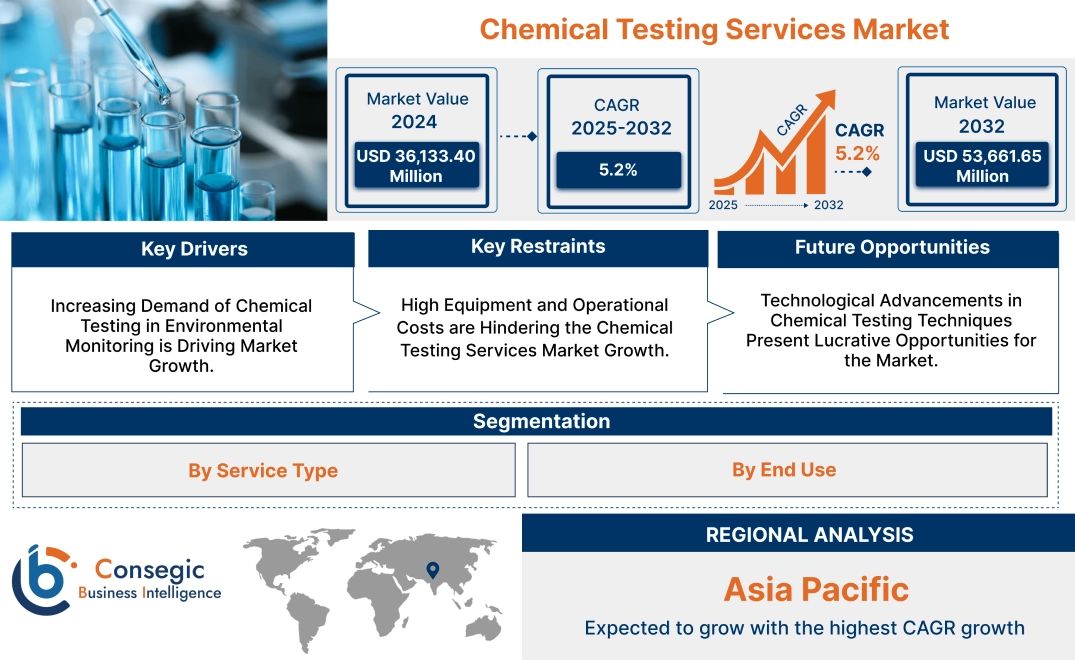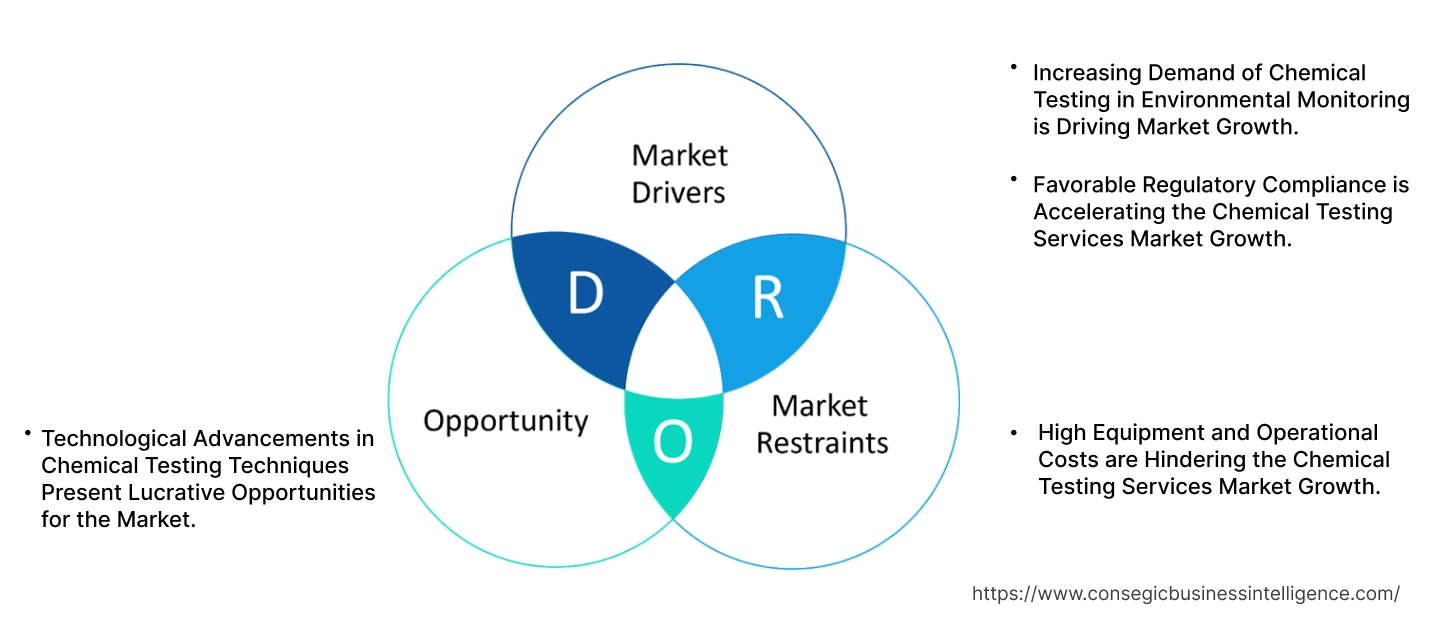Chemical Testing Services Market Size:
Chemical Testing Services Market size is growing with a CAGR of 5.2% during the forecast period (2025-2032), and the market is projected to be valued at USD 53,661.65 Million by 2032 from USD 36,133.40 Million in 2024.
Chemical Testing Services Market Scope & Overview:
Chemical testing involves the process of identifying the chemical composition, properties, purity, and behavior of a substance through various experimental methods. It plays a pivotal role across various sectors, ensuring quality, safety, and efficiency in processes and products. Chemical testing employs a wide array of analytical techniques such as chromatography, spectroscopy, mass spectrometry, wet chemistry, and instrumental testing among others tailored to specific requirements. The key application of these services encompasses quality assurance, safety assessment, regulatory compliance, and research & development among others. Owing to its extensive applications, testing is chemical testing serves a key role across diverse sectors, including, pharmaceutical & biotechnology, food & beverage, environmental, chemical & petrochemical, consumer goods, cosmetics & personal care, electrical & electronics, automotive, and others.
How is AI Impacting the Chemical Testing Services Market?
AI is revolutionizing the chemical testing services market by improving efficiency, accuracy, and speed across various stages, from research and development to quality control. AI-powered tools are enabling smarter simulations, more accurate measurements, and deeper insights into chemical reactions and material properties. This is leading to faster innovation, optimized production processes, and reduced costs. Further, AI-powered digital twins simulate real-world testing scenarios, enabling faster prototyping and optimized product design before physical testing.
Chemical Testing Services Market Dynamics - (DRO) :
Key Drivers:
Increasing Demand of Chemical Testing in Environmental Monitoring is Driving Market Growth.
Environmental monitoring involves the systematic collection of data to assess the quality of the environment. This process includes tracking air, water, and soil conditions to detect pollution levels, climate change, and ecosystem health. The evaluation of water quality relies on the assessment of parameters such as pH, dissolved oxygen levels, nutrient concentration, and the identification of heavy metals such as mercury, lead, and cadmium among others.
Soil testing is another critical aspect, with tests assessing parameters such as pH, organic matter content, nutrient levels, and the presence of contaminants like pesticides and hydrocarbons. Air quality monitoring heavily relies on chemical testing to measure criteria pollutants such as particulate matter, ozone, and nitrogen dioxide, as well as a wide range of volatile organic compounds. Furthermore, the scope of environmental monitoring has expanded to include emerging contaminants such as microplastics, and per- and polyfluoroalkyl substances (PFAS).
- For instance, in December 2024, the S. Environmental Protection Agency finalized amendments to its regulations governing the review of new chemicals under the Toxic Substances Control Act (TSCA). These amendments aim to ensure that all new per and polyfluoroalkyl substances (PFAS) and other persistent, bioaccumulative, and toxic (PBT) chemicals undergo a thorough safety review before entering the U.S. market. This increased scrutiny of PFAS and other potentially harmful chemicals creates the requirement for robust chemical testing.
Overall, the increased requirement for environmental monitoring, driven by concerns like climate change and emerging contaminants, necessitates robust chemical testing.
Favorable Regulatory Compliance is Accelerating the Chemical Testing Services Market Growth.
Regulatory compliance involves ensuring that a company or product meets all relevant laws, regulations, and standards set by authorities. This process is essential for maintaining product safety, quality, and environmental protection. This driver stems from the increasing stringency of regulations across various sectors, which necessitates thorough chemical testing and validation to ensure products meet safety and quality standards. This requirement spans multiple sectors, including food and beverages, environmental monitoring, and industrial manufacturing among others.
Regulatory authorities such as the U.S. Food Safety and Inspection Service (FSIS), the European Food Safety Authority (EFSA), and the Food Safety and Standards Authority of India (FSSAI) among others enforce stringent standards in the food and beverage sector to ensure product safety and quality amid increasing concerns. Their regulations encompass testing contaminants, food additives, nutritional information, and allergens, positively impacting the requirement for chemical testing.
- For instance, in August 2022, the Food Safety and Standards Authority of India introduced the Food Safety and Standards (Packaging) Second Amendment Regulations, 2022. This amendment updates the specific migration limits for substances in food contact plastics as outlined in the Food Safety and Standards (Packaging) Regulations, 2018. The amendment increases the number of regulated substances from seven to nine by including antimony and di(2-ethylhexyl) phthalate (DEHP). This necessitates rigorous chemical testing to ensure compliance with these updated standards.
Overall, the increasing stringency of regulations across various sectors drives the requirement for chemical testing to ensure compliance and maintain product safety and quality.
Key Restraints:
High Equipment and Operational Costs are Hindering the Chemical Testing Services Market Growth.
Chemical testing services rely on sophisticated instruments, such as mass spectrometers, gas and liquid chromatographs, nuclear magnetic resonance (NMR) spectrometers, and X-ray fluorescence (XRF) analyzers. These instruments are vital for accurate and precise measurements but come with a substantial price tag. Moreover, instruments require regular calibration to maintain accuracy, which involves additional costs. Upgrading to the latest technology is necessary to stay competitive, leading to recurring capital expenses. Additionally, the maintenance of these instruments is both complex and expensive.
Beyond the initial investment in equipment, operational costs represent a significant ongoing financial burden for chemical testing service providers. High-end analytical instruments are energy-intensive. Moreover, chemical testing requires consumables such as reagents, gases, columns, and solvents. The cost of these materials adds up. Furthermore, maintaining a controlled laboratory environment, including ventilation, temperature control, and safety equipment, incurs ongoing expenses. Also, ensuring data accuracy and reliability through quality control measures and maintaining accreditations adds to operational costs. Overall, the high cost of equipment and operations poses a significant constraint to the chemical testing services market expansion.
Future Opportunities :
Technological Advancements in Chemical Testing Techniques Present Lucrative Opportunities for the Market.
As industries become more complex and regulations more stringent, the role of advanced technologies in chemical testing is expanding, creating significant new chemical testing services market opportunities. Traditional methods are increasingly being supplemented or replaced by more sophisticated techniques such as chromatography, mass spectrometry, and nuclear magnetic resonance (NMR) spectroscopy. Advancements in these sophisticated technologies offer higher sensitivity, faster processing times, and the ability to analyze complex mixtures at trace levels positively impacting the requirement for chemical testing services in the future.
- For instance, in 2024, Plasmion, a company specializing in chemical testing, developed a technology called SICRIT (Soft Ionization by Chemical Reaction in Transfer) that is advancing mass spectrometry. SICRIT enables direct measurements without sample preparation, allowing for instant testing of substances. The increased sensitivity and broad range of ionization offered by SICRIT enhance laboratory efficiency and potentially prevent product contamination.
High-throughput screening (HTS) technologies enable the rapid testing of numerous samples simultaneously, significantly increasing efficiency, particularly in drug discovery and environmental monitoring. The emergence of portable and handheld analytical instruments, such as portable X-ray fluorescence (XRF) analyzers and handheld Raman spectrometers, is expanding the scope of on-site testing. Furthermore, the integration of IoT and cloud computing advances data management and service delivery. Remote monitoring of instruments and data analysis capabilities enhance operational flexibility and reduce downtime, making chemical testing more accessible and efficient. These technological advancements are expected to create new chemical testing services market opportunities.
Chemical Testing Services Market Segmental Analysis :
By Service Type:
Based on service type, the market is categorized into chemical composition analysis, chemical trace analysis, material testing, contamination detection and analysis, regulatory compliance testing, and others.
Trends in the Service Type:
- Integration of advanced analytical technologies supports improvement in data quality, faster turnaround times, and a deeper understanding of the chemical properties of substances under investigation.
- Increasing requirement for high throughput testing by laboratories to process larger volumes of samples more efficiently, reducing turnaround times and improving productivity.
- Development of rapid and onsite testing methods to enable timely decision-making and facilitate faster responses in various applications.
- The rise in specialized testing for emerging materials is a trend positively impacting innovation and ensuring the safe and effective use of these materials in various applications.
The chemical composition analysis segment accounted for the largest market share of 36.24% in 2024.
- Chemical composition analysis focuses on determining the precise chemical makeup of substances, including the identification and quantification of individual elements and compounds.
- It employs various techniques including chromatography, spectroscopy, and other techniques to determine the composition of chemicals.
- Key applications of this service encompass quality control within the pharmaceutical sector, ensuring product quality and safety in the food and beverage sector, assessing environmental parameters such as water quality and air pollution, characterizing materials for research and development in materials science, and aiding in forensic investigations.
- The requirement for this service is driven by several factors, including stringent regulatory requirements across various sectors, the ongoing need for sophisticated analytical techniques in research and development activities, and continuous advancements in analytical instrumentation, leading to faster, more sensitive, and automated systems.
- As a result, chemical composition testing service remains a crucial and dominant segment within the market, driven by strong requirements across various sectors and supported by continuous advancements in analytical technologies.
The chemical trace analysis segment is expected to grow at the fastest CAGR over the forecast period.
- Chemical trace testing, also known as trace analysis, is a process that identifies and measures low levels of contaminants and residues in a sample.
- The growing emphasis on environmental protection, food safety, and public health is driving significant growth in this segment. This need is fueled by factors such as increasing public awareness about environmental pollution, stricter regulations regarding contaminants in food and the environment, and the emergence of new and emerging contaminants.
- Furthermore, continuous advancements in analytical technologies are driving significant market growth. These advancements encompass the development of more sensitive detectors, the refinement of sample preparation techniques to minimize matrix effects, and the integration of automation to enhance efficiency and throughput.
- For instance, in October 2024, Thermo Fisher Scientific Inc. launched its new Thermo Scientific iCAP MX Series ICP-MS to simplify trace element testing with inductively coupled plasma mass spectrometry (ICP-MS). The launch includes a single quadrupole Thermo Scientific iCAP MSX ICP-MS and triple quadrupole Thermo Scientific iCAP MTX ICP-MS designed for environmental, food, and research labs to analyze routine and challenging trace elements for the detection and mitigation of harmful substances.
- This ongoing innovation ensures that trace chemical testing continues to evolve and meet the increasing requirement for accurate and reliable detection of trace contaminants across various sectors.
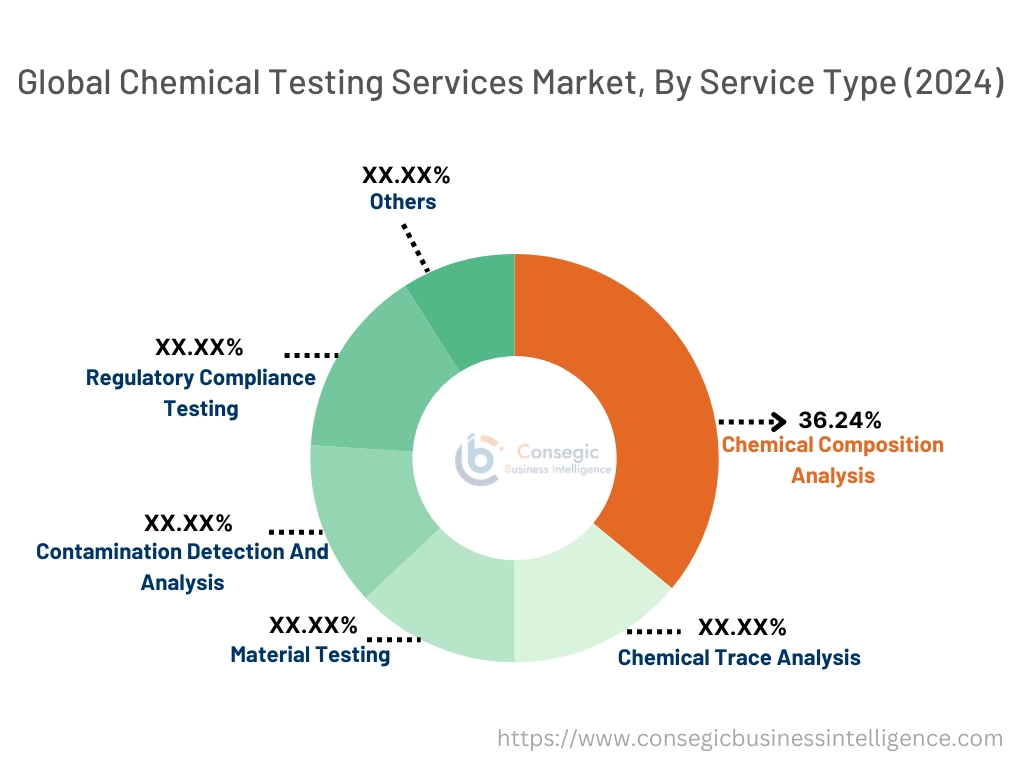
By End Use:
Based on end use, the market is categorized into pharmaceutical & biotechnology, food & beverage, environmental, chemical & petrochemical, consumer goods, cosmetics & personal care, electrical & electronics, automotive, and others.
Trends in the End Use:
- Growing focus on the development of biologics is a trend creating the requirement for specialized testing services to characterize these complex molecules and assess their purity, potency, and stability.
- The increasing demand for natural and organic cosmetics is a trend driving the need for testing services to verify the authenticity and safety of natural ingredients and to ensure the absence of harmful chemicals.
The pharmaceutical & biotechnology segment accounted for the largest market share in the year 2024.
- Chemical testing plays a critical role throughout the pharmaceutical and biotechnology sectors, encompassing a wide range of applications. In drug discovery, facilitates compound identification and characterization, while preclinical studies rely on extensive chemical testing to evaluate drug safety, efficacy, and pharmacokinetics.
- Quality control and assurance are paramount, requiring rigorous testing of raw materials, in-process controls throughout manufacturing, and comprehensive assessment of finished products. The rise of biologics has increased the need for sophisticated analytical techniques to characterize complex molecules and assess critical parameters including purity, potency, stability, toxicity, pharmacokinetics, and pharmacodynamics.
- Furthermore, compliance with stringent regulatory guidelines, such as GMP (Good Manufacturing Practices), necessitates comprehensive testing throughout the drug development and manufacturing process. Data generated from these tests is crucial for regulatory submissions to agencies supporting the approval of new drugs and therapies.
- Overall, chemical testing plays a vital role in ensuring the safety, efficacy, and quality of medications supporting the segment trajectory in the chemical testing services market analysis.
The environmental segment is expected to grow at the fastest CAGR over the forecast period.
- Chemical testing plays a crucial role in environmental monitoring as it provides vital information about the quality of air, water, soil, and biological systems.
- In aquatic environments, testing parameters such as pH, dissolved oxygen, and nutrient levels are essential for evaluating water quality. Similarly, the detection of heavy metals such as mercury, lead, and cadmium provides crucial information about potential industrial pollution sources.
- Soil testing assesses parameters like pH, organic matter content, nutrient levels, and the presence of contaminants such as pesticides and hydrocarbons.
- Air quality monitoring heavily relies on chemical testing to measure criteria pollutants such as particulate matter, ozone, and nitrogen dioxide, as well as a wide range of volatile organic compounds.
- Furthermore, the scope of environmental monitoring extends to emerging contaminants, such as pharmaceuticals, personal care products, microplastics, and per- and polyfluoroalkyl substances (PFAS). The growing need for chemical testing in environmental monitoring fuels the trajectory of testing services.
- For instance, in February 2022, Element Materials Technology opened a new environmental testing laboratory in Doha, Qatar bringing greater capacity and capability to customers in the region. The new laboratory offers environmental testing supporting customers to meet their environmental obligations through a comprehensive range of laboratory and field-based environmental testing services.
- Overall, chemical testing plays a vital role in environmental monitoring, driving chemical testing services market trends.
Regional Analysis:
The regional segment includes North America, Europe, Asia Pacific, the Middle East and Africa, and Latin America.
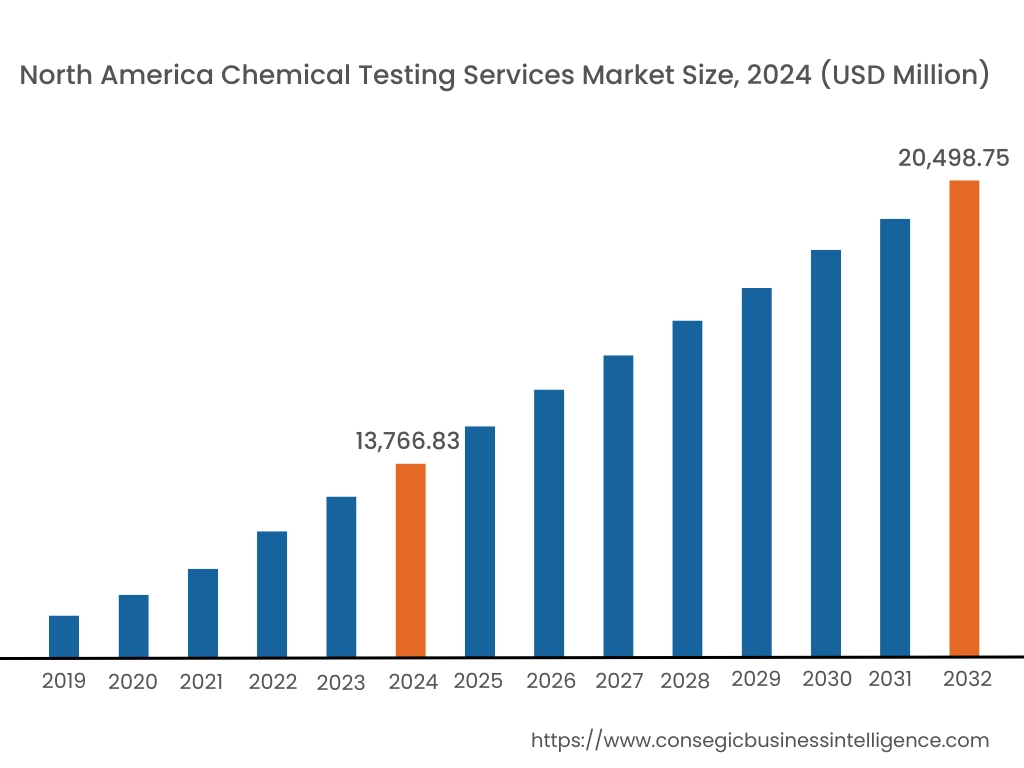
In 2024, North America accounted for the highest market share at 38.10% and was valued at USD 13,766.83 Million and is expected to reach USD 20,498.75 Million in 2032. In North America, the U.S. accounted for the highest market share of 71.22% during the base year of 2024. North America dominates the global chemical testing services market expansion, primarily the region's rigorous regulatory landscape. Sectors such as consumer goods, food and beverages, environmental monitoring, and textiles are subject to stringent regulations to ensure product safety, environmental protection, and public health. Moreover, agencies such as the Environmental Protection Agency (EPA) set stringent guidelines for monitoring and controlling pollutants in air, water, and soil.
- For instance, the Good Neighbor Plan is a finalized rule in March 2023 that aims to address the issue of nitrogen oxide emissions that travel across state borders, affecting air quality in downwind states. This rule is part of the Clean Air Act's requirements to safeguard public health and the environment. Chemical testing is essential for sectors to comply with these regulations, driving their need in the region.
Additionally, North America serves as a center for technological innovation, with its sectors progressively adopting advanced analytical methods to improve product quality, streamline processes, and foster research and development, influencing the requirement for services for chemical testing. The combination of the aforementioned factors and trends is driving a substantial trajectory in the North American chemical testing services market share.
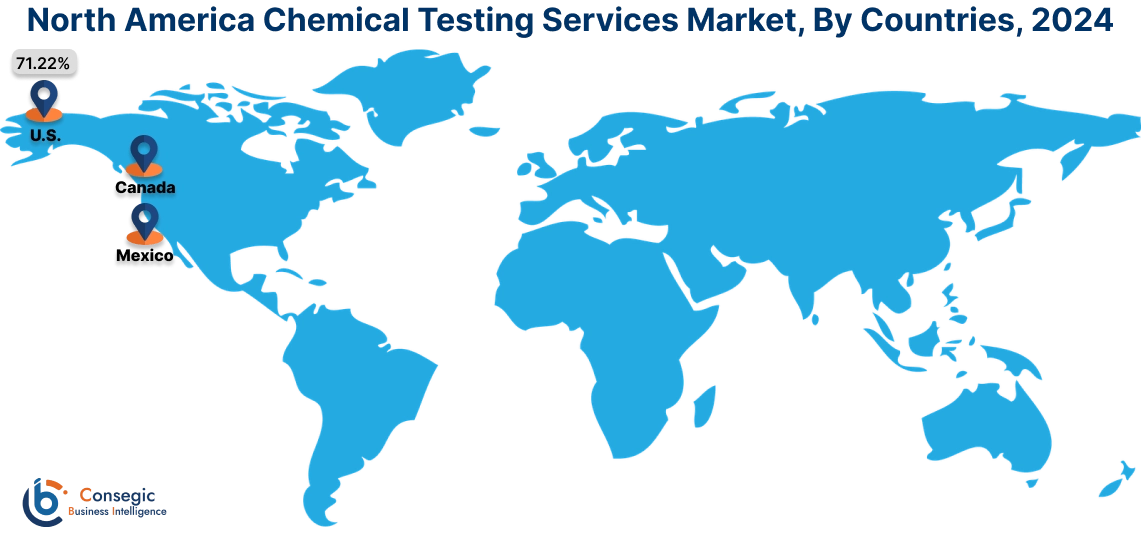
Asia Pacific is experiencing the fastest growth with a CAGR of 5.8% over the forecast period. The chemical testing services market trend across the region is attributed to rapid industrialization across countries such as China, India, and South Korea. This growth has led to a proliferation of manufacturing facilities, necessitating rigorous quality control and compliance measures. The development of complex supply chains within these economies further emphasizes the need for robust quality control mechanisms. Chemical testing plays a crucial role in this context, providing essential testing, validation, and verification services. Furthermore, regulatory bodies across the region are increasingly implementing stringent standards for product safety, environmental protection, and consumer health. For instance, China's implementation of the China Compulsory Certification system mandates rigorous testing and certification of products, while India's Bureau of Indian Standards enforces strict guidelines across various sectors. These regulatory frameworks significantly contribute to the growing requirement for services for chemical testing in the Asia Pacific region.
Europe presents a significant contribution to the chemical testing services market analysis. The European Union (EU) has implemented comprehensive regulations that mandate rigorous testing of chemicals to ensure safety and compliance. Regulations such as the Registration, Evaluation, Authorisation, and Restriction of Chemicals (REACH), the European Food Safety Authority (EFSA) guidelines, and the European Medicines Agency (EMA) standards are examples of stringent protocols that require regular and precise chemical testing. The growth of key sectors such as the food and beverage sector, with its emphasis on food safety and consumer demand for high-quality products, further fuels this need. The automotive sector, particularly with the rise of electric vehicles, requires extensive chemical testing for materials like lithium-ion batteries. Moreover, the chemical sector itself, a major part of the European economy, relies heavily on chemical testing for quality control, product development, and environmental compliance.
Latin America is an emerging region in the chemical testing services market share, with significant innovation potential. The requirement for chemical testing services in Latin America is driven by the region's significant presence in key industries such as oil & gas and agriculture. In the oil and gas sector, which plays a crucial role in the economies of countries like Brazil, Mexico, and Venezuela, rigorous chemical testing is essential. This includes analyses such as crude oil characterization, contaminant identification, and monitoring of chemical additives to ensure product quality, environmental compliance, and operational safety. Furthermore, Latin America is a major agricultural producer. The region's agricultural output is subject to stringent local and international regulations, necessitating rigorous testing of pesticides, herbicides, and fertilizers to ensure food safety and environmental protection. Overall, Latin America's dynamic economic landscape, driven by sectors such as oil and gas, agriculture, and manufacturing, is propelling the chemical testing services market demand.
The Middle East and Africa (MEA) region is witnessing notable demand characterized by significant potential. The MEA regions are experiencing rapid industrialization and urbanization, particularly in countries such as Saudi Arabia, the United Arab Emirates, and South Africa, driving significant rises in the oil and gas, petrochemicals, food and beverages, and agriculture sectors. This has led to an increased need for chemical testing services. These sectors rely on chemical testing to ensure the quality, safety, and compliance of their products with international standards. Furthermore, the MEA region is attracting significant foreign investment, particularly in sectors such as oil and gas, pharmaceuticals, and food processing. These investments are accompanied by global partnerships, which bring with them the need to meet international standards for product quality and safety, driving the demand for chemical testing.
Top Key Players and Market Share Insights:
The Chemical Testing Services market is highly competitive with major players providing services to the national and international markets. Key players are adopting several strategies in research and development (R&D) and product innovation to hold a strong position in the global Chemical Testing Services market. Key players in the Chemical Testing Services industry include-
- TÜV SÜD (Germany)
- Intertek Group plc (UK)
- Applied Technical Services, LLC (U.S.)
- Agilent Technologies, Inc. (U.S.)
- Sandberg LLP (UK)
- SGS Société Générale de Surveillance SA (Switzerland)
- UL LLC. (U.S.)
- Bureau Veritas (France)
- IMR Test Labs (U.S.)
- Eurofins Scientific (Luxembourg)
Recent Industry Developments:
New Launch:
- In June 2024, Analytical Resource Labs, (ARL) a provider of analytical testing services, announced the launch of a new PFAS testing service. PFAS or Per- and Poly- fluoroalkyl substances, are a large group of man-made chemicals used in various industrial processes. Due to their widespread use, PFAS are now found in many environments and research is ongoing to understand their potential health impacts. ARL is committed to providing accurate and reliable testing to help ensure the safety of consumer products.
Expansion:
- In February 2022, Element Materials Technology opened a new environmental testing laboratory in Doha, Qatar bringing greater capacity and capability to customers in the region.
Chemical Testing Services Market Report Insights :
| Report Attributes | Report Details |
| Study Timeline | 2019-2032 |
| Market Size in 2032 | USD 53,661.65 Million |
| CAGR (2025-2032) | 5.2% |
| By Service Type |
|
| By End Use |
|
| By Region |
|
| Key Players |
|
| North America | U.S. Canada Mexico |
| Europe | U.K. Germany France Spain Italy Russia Benelux Rest of Europe |
| APAC | China South Korea Japan India Australia ASEAN Rest of Asia-Pacific |
| Middle East and Africa | GCC Turkey South Africa Rest of MEA |
| LATAM | Brazil Argentina Chile Rest of LATAM |
| Report Coverage |
|
Key Questions Answered in the Report
How big is the Chemical Testing Services market? +
In 2024, the Chemical Testing Services market is USD 36,133.40 Million.
Which is the fastest-growing region in the Chemical Testing Services market? +
Asia Pacific is the fastest-growing region in the Chemical Testing Services market.
What specific segmentation details are covered in the Chemical Testing Services market? +
Service Type and End Use segmentation details are covered in the Chemical Testing Services market.
Who are the major players in the Chemical Testing Services market? +
TUV SUD (Germany), Intertek Group plc (UK), and SGS Société Générale de Surveillance SA (Switzerland) are some of the major players in the market.
